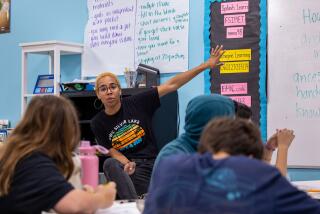And Now the News, Written and Broadcast by Sixth-Graders
Joseph Renteria, 12, sat nervously outside the school library holding a microphone. He checked his clothes, straightened his shirt collar and pushed back his hair. Then he looked at the video camera and began reporting the news.
With a voice as stern as a 12-year-old can possibly have--he began, stumbling on only a few of the bigger words.
As he moved into the middle of his newscast, Renteriaâs jitters faded away.
Waiting on the side for her cue, Stephanie Padilla, 12, reviewed her notes. She was a two-year veteran of the news program. Once in front of the camera, she read the news easily and with confidence.
âThe first time I got nervous, but now I am used to the camera,â Padilla said.
Trying to hold the camera steady was Vanessa Vazquez, 12, who counted down slowly, â5-4-3-2-1, youâre on.â After taping was finished, the editing, dubbing, graphics and background music, all done by students, completed the news program that is broadcast on a closed-circuit system twice a month to every classroom at Rivera Middle School in Pico Rivera.
Sixth- and seventh-grade students report on school activities, local, national and world events.
Instructor Rudy Lopez proposed the idea for a televised newscast to the schoolâs administration about four years ago. After writing a proposal to the state, the school was awarded a $13,000 grant for the television program.
The program is patterned after a commercial TV newscast. There are field reporters, anchor persons, weather reporters, sportscasters and interviewers.
âItâs fun to be in front of the camera,â Renteria said. âIâm also in the drama club, so Iâm used to talking in front of people.â
The program is a chance for students to be in front of the camera and work behind the scenes as editors, news writers, camera operators and script readers. For the teachers, the local newscast program works as a teaching tool, increasing the studentsâ language skills in oral and written form--not to mention the exposure to national and world events.
In a small studio in the school library, three seventh-graders sat around a computer typing the script for the next show.
George Padilla, Rhea Jennex and Carlos Lopez, all 12, began assigning local TV roles to themselves from the lineup of Los Angeles newscasters. Carlos Lopez was picked to be the next Fritz Coleman, the NBC weatherman, Jennex was cast as Ann Martin, an ABC anchor, and George Padilla, two students said giggling, is Dr. George Fischbeck, the weatherman on ABC.
âWe get a little crazy in here. Mr. Lopez has to calm us down sometimes. Most of the time we come in here and get right to work,â Jennex said.
School board members acknowledged the effort the students put into the show by awarding them a $15,000 grant in October. The money, Rudy Lopez said, was spent for new television monitors in all classrooms. He also purchased video cameras, microphones and a computer.
The students rewrite articles from the Los Angeles Times or scholastic magazines, Rudy Lopez said.
âKids come into the library all the time and write reports from the encyclopedias. Our encyclopedia today is the news media,â he said.
Complete with graphics and background music, the studentsâ program is called Rivera Eagleâs News.
There are two levels of programming, an introductory course for sixth-graders and an advanced program for seventh-graders. The sixth-graders work with another teacher, Sharon Gleason. Each class is divided in half and the students have two weeks to produce the show. The program is designed as a basic introductory course in broadcast news. The students stay in the studio and read reports, edit the news stories, operate the computers and learn the basic functions of video cameras.
In the seventh grade, the young news crew tapes network reports to be included in their broadcast. The students report on school activities and have interviewed school officials.
Rudy Lopez said his goal is to extend the program to eighth-graders; he wants them to write editorials and be able to analyze news events.
âI want the kids to see the computer and video camera as a tool like the calculator, a tool that makes your job much easier,â he said.
Rudy Lopez hopes the newscast will redefine the studentsâ viewing pleasures. Instead of watching cartoons and situation comedies, the students will be more interested in national and world events.
He got the idea of creating a news program for students several years ago, he said, when he saw his son become fascinated with television news when he was in elementary school.
Rudy Lopez, who has been in the El Rancho Unified School District since 1977, has stopped teaching in the classroom and is now dedicating his time to developing a news program for the districtâs seventh- and eighth-grade classes.
Before the newscast is televised to the classrooms, Rudy Lopez and Gleason prepare a work sheet for other teachers with a series of questions relating to the newscast for classroom discussion.
Students report on issues such as an increase in cholesterol among children, hazing in college, the history of education, and a discussion of the role of business in education. Many of the seventh-graders who were polled envisioned careers in the news field. âI hear they make good money,â Stephanie Padilla said.
More to Read
Sign up for Essential California
The most important California stories and recommendations in your inbox every morning.
You may occasionally receive promotional content from the Los Angeles Times.










